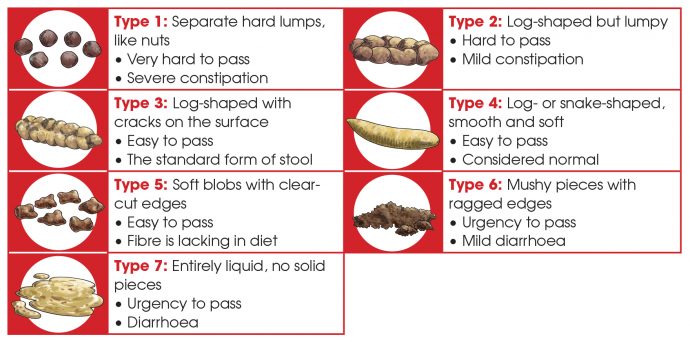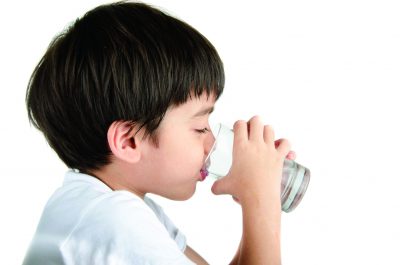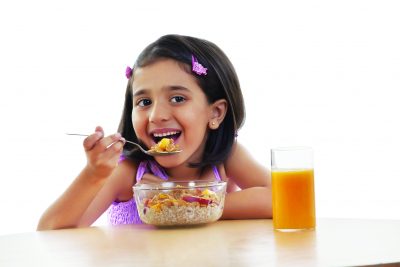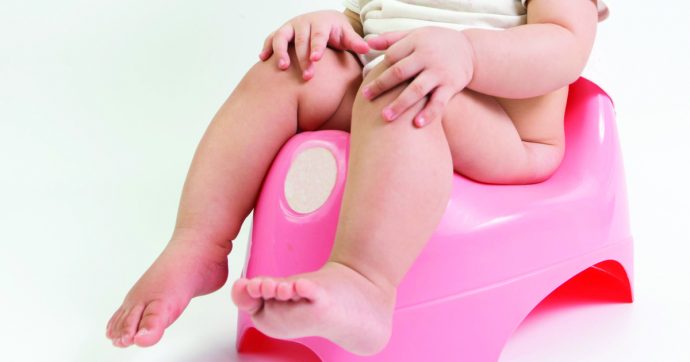Bowel movement is part of nature’s call. The appearance of your child’s stool can show if his bowel movement and digestive system are healthy or not.
Stool consists of mostly undigested food, proteins, bacteria, salts and other substances. Stool can vary in shape, texture and colour, depending on individuals, but generally, normal stool is brown, log- or sausage-shaped, and easy to pass, with a texture that is between soft and firm.
Shape and texture
The Bristol stool chart explains the shape and texture of stool. This will help to indicate if your child’s bowel movement is normal or if he has constipation or diarrhoea.

Colour: what’s the problem?
An unusual colour of stool may indicate health problems or merely the result of eating certain food.
- Brown is the normal colour of stool. The colour comes from a substance in bile called bilirubin, which forms when old red blood cells break down.
- A hint of green in stool is normal. When they are fully green, it could mean that lots of green foods (e.g. spinach) were consumed, or food was passed through the digestive tract too fast.
- Black tarry stool may be due to the consumption of liquorice, iron supplements, or bismuth medications. If it is not the case, it could be a sign of bleeding in the upper part of the digestive tract.
- White, grey, or pale stool indicates a lack of bile, e.g. because the gallbladder or bile ducts are blocked. Some anti-diarrhoea medications also cause white stool.
- Greasy, yellow stool contains a high amount of fat. This could be a sign of malabsorption disorders (e.g. coeliac disease) or problems with enzyme/bile production.
- Red stool could be a sign of bleeding in the lower part of the digestive tract. Bright fresh blood on the top of the stool may indicate haemorrhoids. A less serious cause is the intake of red foods, such as beets, cranberries or tomato juice.
- Orange stool may be from foods rich in beta-carotene like carrots, pumpkins or sweet potatoes. Other reasons include blocked bile ducts or consumption of certain medications like antacids or rifampicin (an antibiotic).
Time & frequency
Generally, your child should not take more than 10-15 minutes in the toilet. If he needs longer time, he may possibly have problems with the digestive system, which include constipation, haemorrhoids or other conditions. The average frequency of a bowel movement is between once every other day to thrice a day. If he is constipated, he is likely to go less frequently. Too often, he may have diarrhoea.
Tips for healthy bowel movement
- Drink plenty of water: Water helps to soften stool and facilitate bowel movements. Children above 4 years old should drink 6-8 glasses of water a day.

- Eat a healthy diet: Include more fibre in your child’s diet with more whole grains, fruits, and veggies. Fibre helps to retain water and provide bulk in stools. Probiotic- rich foods like yoghurt and cultured drink can also help to promote better gut health.

- Be active regularly: Have your child to play more outdoor games and sports, as active lifestyle helps to encourage normal bowel function.

Healthy bowel movement with normal stool is a sign of a healthy digestive system. By practising healthy eating and active living, your child can maintain his digestive health and will have a better toilet time – less time in the toilet, less straining, and easier passing of stool. Check with your doctor if you suspect any issues with your child’s stool and bowel movements.







Comments